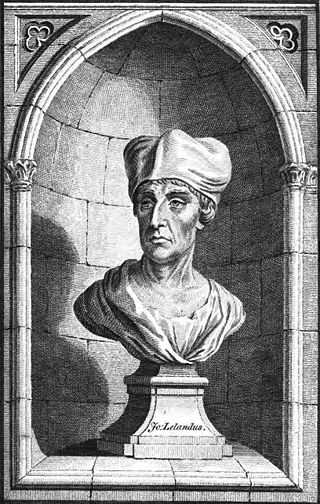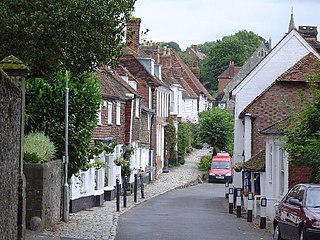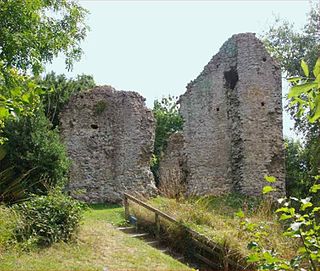Further reading
- M. Konrath: The Poems of William of Shoreham, ab. 1320, vicar of Chart-Sutton; re-edited from the unique manuscript in the British Museum (Early English Text Society, 1902) - available online
William of Shoreham (fourteenth century) was an English poet.
Little is known of his life, but he probably lived in Shoreham, Kent and was vicar of Chart Sutton (near Leeds, Kent). Seven poems in English are attributed to him, all contained in a single manuscript now in the British Library (Add MS 17376). Four of the poems are didactic and address points of Christian doctrine, the other three are in praise of the Virgin Mary (one of them a translation from Robert Grosseteste's Latin). He was once thought to be the author of an English psalter, but this is now considered spurious.

Edward John Moreton Drax Plunkett, 18th Baron of Dunsany,, commonly known as Lord Dunsany, was an Anglo-Irish writer and dramatist. He published more than 90 books during his lifetime, and his output consisted of hundreds of short stories, plays, novels, and essays. He gained a name in the 1910s as a great writer in the English-speaking world. Best known today are the 1924 fantasy novel, The King of Elfland's Daughter, and his first book, The Gods of Pegāna, which depicts a fictional pantheon. Many critics feel his early work laid grounds for the fantasy genre.

Samuel Butler was an English poet and satirist. He is remembered now chiefly for a long satirical poem titled Hudibras.

Sir Thomas Wyatt was a 16th-century English politician, ambassador, and lyric poet credited with introducing the sonnet to English literature. He was born at Allington Castle near Maidstone in Kent, though the family was originally from Yorkshire. His family adopted the Lancastrian side in the Wars of the Roses. His mother was Anne Skinner, and his father Henry, who had earlier been imprisoned and tortured by Richard III, had been a Privy Councillor of Henry VII and remained a trusted adviser when Henry VIII ascended the throne in 1509.

John Leland or Leyland was an English poet and antiquary.

John William Burgon was an English Anglican divine who became the Dean of Chichester Cathedral in 1876. He was known during his lifetime for his poetry and his defense of the historicity and Mosaic authorship of Genesis. Long after his death he was remembered chiefly for his defense of the Byzantine text-type.

William Lisle Bowles was an English priest, poet and critic.

Samuel Palmer Hon.RE was a British landscape painter, etcher and printmaker. He was also a prolific writer. Palmer was a key figure in Romanticism in Britain and produced visionary pastoral paintings.

Shoreham is a village and civil parish in the Sevenoaks District of Kent, England. It is located 5.2 miles north of Sevenoaks.
Cleanness is a Middle English alliterative poem written in the late 14th century. Its unknown author, designated the Pearl poet or Gawain poet, also appears, on the basis of dialect and stylistic evidence, to be the author of Sir Gawain and the Green Knight, Pearl, and Patience, and may have also composed St. Erkenwald.

William Lambarde was an English antiquarian, writer on legal subjects, and politician. He is particularly remembered as the author of A Perambulation of Kent (1576), the first English county history; Eirenarcha (1581), a widely read manual on the office and role of justice of the peace; and Archeion, a discourse that sought to trace the Anglo-Saxon roots of English common law, prerogative and government.

Sutton Valence is a village about five miles (8 km) SE of Maidstone, Kent, England on the A274 road going south to Headcorn and Tenterden. It is on the Greensand Ridge overlooking the Vale of Kent and Weald. St Mary's Church is on the west side of the village on Chart Road, close to the junction of the High Street with the A274. Another landmark is Sutton Valence Castle on the east side of the village, of which only the ruins of the 12th-century keep remain, under the ownership of English Heritage.

White Kennett was an English bishop and antiquarian. He was educated at Westminster School and at St Edmund Hall, Oxford, where, while an undergraduate, he published several translations of Latin works, including Erasmus' In Praise of Folly.

Huttoft is a village in the East Lindsey district of Lincolnshire, England, about 4 miles (6 km) east of the market town of Alford, on the A52 road between Ingoldmells and Sutton-on-Sea. John Betjeman, later England's Poet Laureate, visited Huttoft in the 1940s and devoted a poem to its parish church.
Chart Sutton is a civil parish and small village on the edge of the Weald of Kent, England. It lies approximately 5 miles (8 km) to the south of Maidstone.
William Disney, D.D. (1731–1807) was an English clergyman and academic, and one of the critics of Edward Gibbon.

St Mary de Haura Church is an Anglican church in the ancient "New Shoreham" area of Shoreham-by-Sea in the district of Adur, one of seven local government districts in the English county of West Sussex. It was founded at the end of the 11th century as a large cruciform church which, due to its original scale, has been described as a collegiate church—a reflection of the port of Shoreham's importance at the time. The former east end of that building survives to form the present church, and much 12th-century work remains. It functions as Shoreham-by-Sea's "town church" for major religious and social events, as well as serving as the town-centre parish. English Heritage has listed it at Grade I for its architectural and historical importance.
Henry Kett was a versatile English clergyman, academic and writer.
George Richards was an English Anglican priest and poet.
Philip Bearcroft, D.D. was an English clergyman and antiquary.

Sutton Valence Castle is a ruined medieval fortification in the village of Sutton Valence in Kent, England. Overlooking a strategic route to the coast, the original castle probably comprised an inner and an outer bailey and a protective barbican, with a three-storey high keep on its southern side.